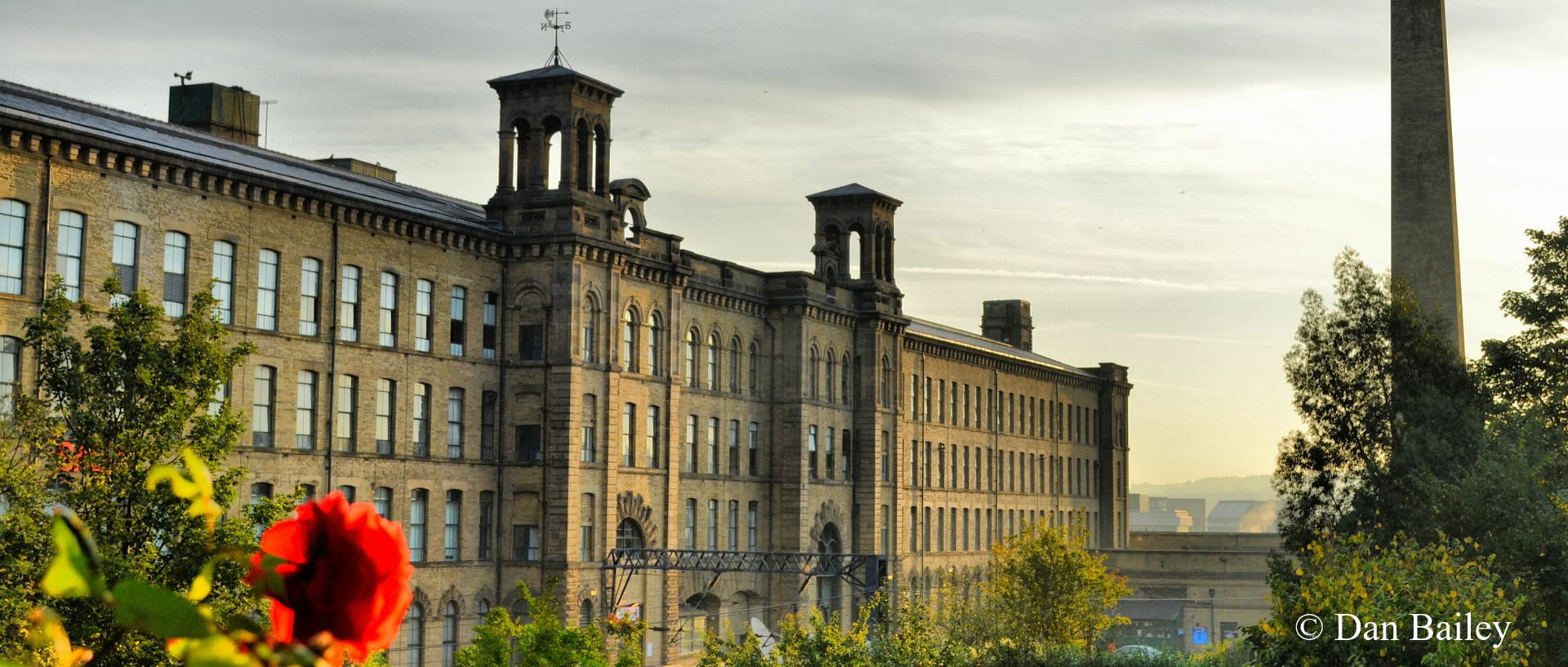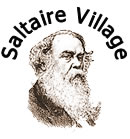|
FREQUENTLY ASKED QUESTIONS ABOUT SALTAIRE
By Roger Clarke
Is Saltaire a museum?
Not at all. Saltaire is a village where people live and work. There are shops, places to eat, private businesses, a lovely park and of course, Salts Mill. The Village is situated on the Leeds to Liverpool canal which runs adjacent to the River Aire. It is served by a railway station with direct links to Bradford, Leeds and Skipton. Saltaire is the home of Shipley College, which uses buildings on Victoria Road and Exhibition Road.
Salts Mill, once a vast, integrated textile mill, is now a commercial enterprise selling quality products to visitors, but also displaying David Hockney paintings and Burmantofts pottery in a grand setting. It is free to enter.
The houses, apart from the almshouses located at the top of Victoria Road, are privately owned. They are all Grade 2 listed.
You will find stunning Italianate architecture, largely unchanged from Victorian times. To make the most of your visit you have to do some walking to appreciate the scale of the place and why it is the largest and best preserved Victorian industrial model village in the country.
Why did Titus Salt build Saltaire?
A – There are many reasons. He was 50 years old in 1853 and had made a fortune from his mills in Bradford. He was already aware of other entrepreneurs who had constructed model villages in other parts of the country. He had first hand experience of the dreadful conditions which existed in Bradford in the 1840s. There was a particularly severe outbreak of cholera in Bradford in 1848. He had clear ideas of what could improve the conditions of his workers, and in many ways Saltaire was built to rectify all the faults which he could see in Bradford. He wanted to be in control of this model project, and to be the only authority here. He wanted to have a business to pass on to his sons. And finally there was genuine philanthropy – “to do good by my fellow men”.
What did Titus Salt manufacture in Saltaire?
A – Alpaca worsted. Worsted is a mixed cloth composed of cotton or silk warp threads (the ones which are vertical) and wool weft threads (the ones which are horizontal). Titus’ skill was in inventing machines which would spin difficult fibres, such as Donskoi wool from Russia which was long and fine. His discovery of a means to spin alpaca, which is hair from a llama-like animal from Peru, was the basis of his successful business. The resulting material was known as “lustre cloth” because it looked like silk and felt like silk but was only a fraction of the cost.
How much did it cost to build the Mill?
A – The site cost £14,000, and the building cost £120,000. It was built in just 2 years from the original plans to completion in 1853.
The whole village, including worker’s houses and the public buildings, was completed in 25 years, and Sir Titus lived to see the finished result in 1876, the year of his death aged 73 years old. The workers’ housing cost £170,000 and the public buildings cost approximately the same. The public buildings are the church and Sunday school, school, Institute, hospital, almshouses, and wash house.
When he died, Sir Titus was had accumulated a fortune of £2 million (£415 million at today’s values), making him one of the richest men in the country.
What was special about the Mill?
A – It was completely integrated, with all the processes of production under one roof. Raw material was delivered from the canal at the northern end of the building and the finished cloth was loaded onto railway trains at the southern end. The process was very efficient.
It is a huge building, standing 6 storeys high and 550 feet long.
The mill also has many unique features. It is fireproof, constructed entirely of locally (Bradford) sourced iron and locally quarried stone. It has smoke burning boilers producing few emissions. It was capable of producing 18 miles of cloth every day, and was open from 6am to 6pm daily (except Sundays and half day Saturday).
The top gallery was for spinning and was the longest room of its kind in the world, being the length of St Paul’s Cathedral.
How many workers worked and lived here?
A – There are 824 houses in the village, accommodating 4,500 people. Everyone living in the village worked in the Mill, and your tenancy depended on you continuing to work there. If you lost your job, you lost your house. There are different kinds of houses for different types of workers (or operatives as Titus called them). There are executive houses on Albert Road, overlooker’s houses on George Street and William Henry Street, and the ordinary workers houses comprise the majority of the rest of the site. Sir Titus himself never lived in the village and never built a house here.
How much did the workers earn?
A – Spinners and weavers earned between 15/- and £1 per week, with rents of about 2/6d per week. Overlookers earned £1 to £1-10 shillings with rents of around 3/6d per week.
Were they paid in cash or tokens?
A – Cash. There is no evidence that Titus used tokens or certificates in lieu of cash. There was no factory shop here. All 40 shops in the village traded independently for cash.
What happened to the Mill when Titus Salt died?
A – A few of his sons continued to run it, especially Titus Junior. Unfortunately he died young at 44 years in 1887. In 1892, the Company went into liquidation, and the Salt family were no longer involved in the business. A series of consortia of businessmen took over, with notable managing directors such as Sir James Roberts and Sir James Hill. In 1958, Illingworth Morris took over, and gradually hived off some of the processes of production to their subsidiaries, and by 1986 the business terminated. The machinery was removed and the building was an empty shell becoming increasingly vandalised.
In 1987, Jonathan Silver, a young entrepreneur who had made a fortune from selling men’s designer clothing through a chain of shops throughout the north of England, bought it and turned it into the commercial enterprise which it is today. He used art, culture and commerce combined together in a unique way in his business, and he retained many of the original features of the Mill within which to display them. Unfortunately Jonathan died in 1997, but his widow Maggie and his brother Robyn continue to run the enterprise.
What happened to the machinery?
A – Many visitors come here expecting to see examples of working spinning machines and looms. They were sold off in 1986, but working examples can still be seen at the Bradford Industrial Museum – unfortunately some 3 miles away from Saltaire, but worth the journey. There are plans for a Visitor Centre in Saltaire at some time in the future. The Industrial Museum website is www.bradfordmuseums.org/industrialmuseum
Who lives in the houses now?
A – In 1933, the Mill Company needed cash to install new machinery, and raised it by selling the houses to a Bradford estate agent who put in electric lighting and took away one bedroom in each house to convert to a bathroom. He then sold the houses to private owner occupiers. The link between the Mill and the houses was broken.
Today the village is partly used as a commuter village, only a relatively short journey from Leeds and Bradford, with good transport links by road and rail. There are many buy-to-let properties. The population of the village is much smaller now, and the average stay here is much shorter.
What about disabled access?
A – The Mill and the Institute have disabled access, but unfortunately the Church does not. The streets of Saltaire are not very wheelchair friendly – the site rises, steeply in parts, from the river and canal. Some of the streets are cobbled. Trees planted on Victoria Road have caused pavements to be uneven in places. Access to the village is not impossible, but could be easier.
Where to eat?
A – You are spoilt for choice! Within the Mill is the Diner on the second floor, and on the third floor (open from Wednesday to Sunday) is the Café in the Opera.
On Victoria Road, there is a wine bar called Don’t Tell Titus selling food (this was always a dry village and Titus would not allow pubs or beer-houses to be built). The village bakery sells food to take away (pies, sandwiches etc) and downstairs there are tearooms with seating. At Number 79, on the corner of Caroline Street and Victoria Road is Vicars, a Christian café which serves meals and snacks. Further up Victoria Road is Massarella’s serving light meals. There is a sandwich shop at Number 16.
The southern boundary of the village is Bingley Road (A650) where there are many places to eat. Find your way to Saltaire traffic roundabout at the Saltaire Road/Bingley Road junction and you will find the Old Tramsheds, and imposing building serving alcohol and meals. Walking from here towards Bradford along the A650 there is Gourmet Corner on your left. On the right are The Countess of Rosse public house, and Websters take way fish and chip shop. A KFC is on the right too. On the left is Indian Spice, takeaway and La Rue, a French restaurant. The restaurant theme continues further towards Bradford, but you need to walk approximately quarter of a mile to reach Da Toninos, Italian restaurant and Zaara’s Indian restaurant. On this same block is Franco’s delicatessen and café, and almost opposite on the other side of the road is Drake’s fish and chip shop with a seating area.
Where can I make comments, good and bad, about my visit?
A – Staff at the Mill will direct you to the management based in the Mill if your comments concern what you have found there.
There is also a World Heritage Site Officer employed by Bradford Council, and you can contact him about anything to do with Saltaire, email craig.mchugh@bradford.gov.uk;
If you wish to comment on the absence of a TIC or anything about tourist information, you can contact Patricia Tillotson, email patricia.tillotson@bradford.gov.uk;
Roger Clarke
May, 2009
|

